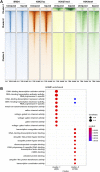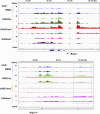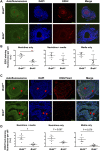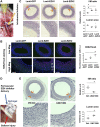Angioplasty induces epigenomic remodeling in injured arteries
- PMID: 35169042
- PMCID: PMC8860099
- DOI: 10.26508/lsa.202101114
Angioplasty induces epigenomic remodeling in injured arteries
Abstract
Neointimal hyperplasia/proliferation (IH) is the primary etiology of vascular stenosis. Epigenomic studies concerning IH have been largely confined to in vitro models, and IH-underlying epigenetic mechanisms remain poorly understood. This study integrates information from in vivo epigenomic mapping, conditional knockout, gene transfer and pharmacology in rodent models of IH. The data from injured (IH-prone) rat arteries revealed a surge of genome-wide occupancy by histone-3 lysine-27 trimethylation (H3K27me3), a gene-repression mark. This was unexpected in the traditional view of prevailing post-injury gene activation rather than repression. Further analysis illustrated a shift of H3K27me3 enrichment to anti-proliferative genes, from pro-proliferative genes where gene-activation mark H3K27ac(acetylation) accumulated instead. H3K27ac and its reader BRD4 (bromodomain protein) co-enriched at Ezh2; conditional BRD4 knockout in injured mouse arteries reduced H3K27me3 and its writer EZH2, which positively regulated another pro-IH chromatin modulator UHRF1. Thus, results uncover injury-induced loci-specific H3K27me3 redistribution in the epigenomic landscape entailing BRD4→EZH2→UHRF1 hierarchical regulations. Given that these players are pharmaceutical targets, further research may help improve treatments of IH.
© 2022 Zhang et al.
Conflict of interest statement
The authors declare that they have no conflict of interest.
Figures



















Similar articles
-
Neointima abating and endothelium preserving - An adventitia-localized nanoformulation to inhibit the epigenetic writer DOT1L.Biomaterials. 2023 Oct;301:122245. doi: 10.1016/j.biomaterials.2023.122245. Epub 2023 Jul 13. Biomaterials. 2023. PMID: 37467597 Free PMC article.
-
Down-regulation of the histone methyltransferase EZH2 contributes to the epigenetic programming of decidualizing human endometrial stromal cells.Mol Endocrinol. 2011 Nov;25(11):1892-903. doi: 10.1210/me.2011-1139. Epub 2011 Sep 8. Mol Endocrinol. 2011. PMID: 21903722 Free PMC article.
-
Nullifying epigenetic writer DOT1L attenuates neointimal hyperplasia.Atherosclerosis. 2020 Sep;308:22-31. doi: 10.1016/j.atherosclerosis.2020.06.002. Epub 2020 Jul 2. Atherosclerosis. 2020. PMID: 32799103 Free PMC article.
-
Recent advances in EZH2-based dual inhibitors in the treatment of cancers.Eur J Med Chem. 2023 Aug 5;256:115461. doi: 10.1016/j.ejmech.2023.115461. Epub 2023 May 5. Eur J Med Chem. 2023. PMID: 37156182 Review.
-
EZH2 methyltransferase and H3K27 methylation in breast cancer.Int J Biol Sci. 2012;8(1):59-65. doi: 10.7150/ijbs.8.59. Epub 2011 Nov 18. Int J Biol Sci. 2012. PMID: 22211105 Free PMC article. Review.
Cited by
-
Promising Strategies for Preserving Adult Endothelium Health and Reversing Its Dysfunction: From Liquid Biopsy to New Omics Technologies and Noninvasive Circulating Biomarkers.Int J Mol Sci. 2022 Jul 7;23(14):7548. doi: 10.3390/ijms23147548. Int J Mol Sci. 2022. PMID: 35886888 Free PMC article. Review.
-
The role of 6-phosphogluconate dehydrogenase in vascular smooth muscle cell phenotypic switching and angioplasty-induced intimal hyperplasia.JVS Vasc Sci. 2024 Aug 2;5:100214. doi: 10.1016/j.jvssci.2024.100214. eCollection 2024. JVS Vasc Sci. 2024. PMID: 39318609 Free PMC article.
-
miR579-3p is an inhibitory modulator of neointimal hyperplasia and transcription factors c-MYB and KLF4.Cell Death Discov. 2023 Feb 22;9(1):73. doi: 10.1038/s41420-023-01364-7. Cell Death Discov. 2023. PMID: 36813774 Free PMC article.
-
Neointima abating and endothelium preserving - An adventitia-localized nanoformulation to inhibit the epigenetic writer DOT1L.Biomaterials. 2023 Oct;301:122245. doi: 10.1016/j.biomaterials.2023.122245. Epub 2023 Jul 13. Biomaterials. 2023. PMID: 37467597 Free PMC article.
-
Nano-based perivascular intervention sustains a nine-month long-term suppression of intimal hyperplasia in vein grafts.Bioact Mater. 2024 Oct 13;44:82-96. doi: 10.1016/j.bioactmat.2024.10.005. eCollection 2025 Feb. Bioact Mater. 2024. PMID: 40438256 Free PMC article.
References
Publication types
MeSH terms
Substances
Grants and funding
LinkOut - more resources
Full Text Sources
Medical
Molecular Biology Databases
